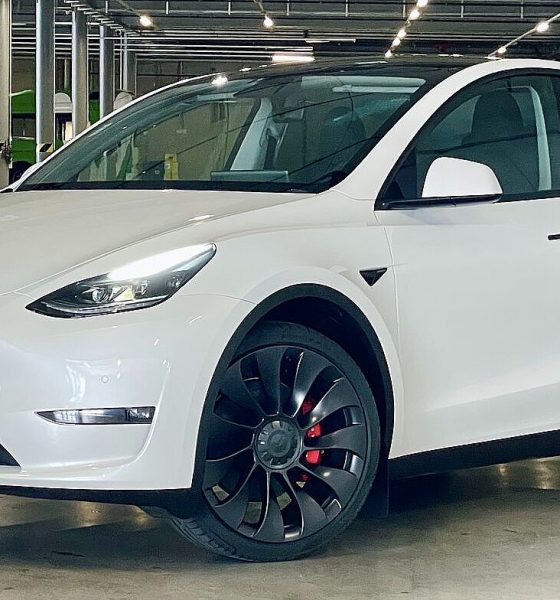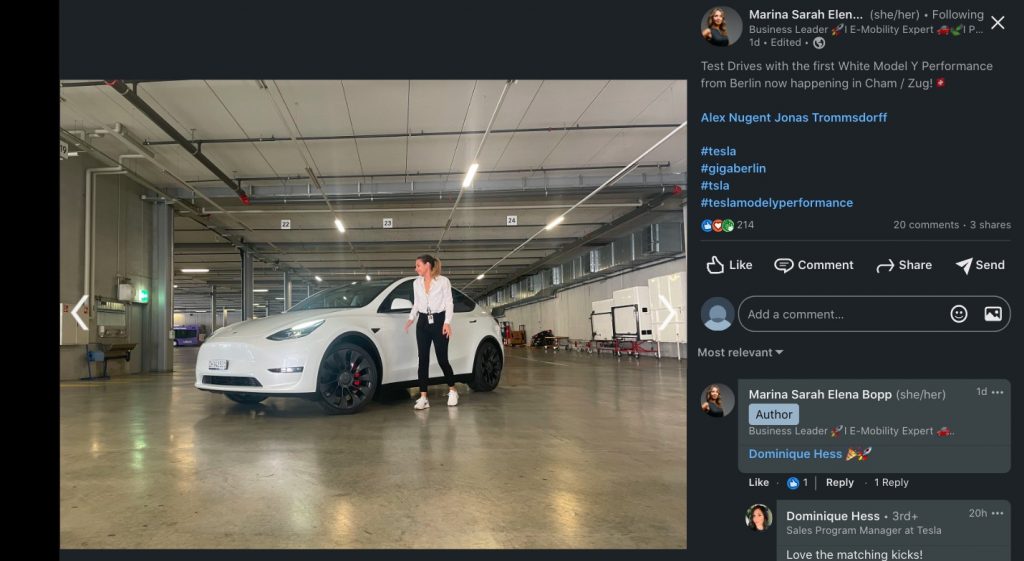

News
Tesla pushes Made-in-Germany Model Y test drives in Switzerland
Potential customers in Switzerland who wish to try out a German-made Tesla Model Y now have the opportunity to take one of the European-made all-electric crossovers for a spin. As per a recent post on LinkedIn, Tesla is offering test drives for its Germany-made Model Y in Cham, Zug, Switzerland.
Several Tesla employees from the area confirmed the program, with Store Supervisor Marina Sarah Elena Bopp noting that the location has received its first white Made-in-Germany Model Y Performance from Giga Berlin. The unit, which is equipped with 21″ Überturbine wheels and an all-black interior, will be used as a test drive unit. Previously available units featured a black color scheme, similar to the first Model Ys delivered in last month’s handover ceremony with CEO Elon Musk.

Needless to say, customers of Tesla’s Cham, Zug location in Switzerland could consider themselves fortunate. Germany-made Model Ys are quite in demand even among Tesla enthusiasts today, after all, as they are produced in one of the electric vehicle maker’s newest factories. Being a Made-in-Germany Tesla, expectations are also high that the Model Ys from Giga Berlin would feature good build quality.
Veteran electric car owners would note that test drives are among the most effective ways to promote Teslas. The Tesla Model Y, while a crossover, is quite unlike any other vehicle in its class thanks to its combination of raw power and breathtaking tech. Having potential customers experience it firsthand would likely be the ideal way to market the vehicle.
Gigafactory Berlin has only been open for a few weeks now, but the facility has experienced its first environmental challenge this week. As per local reports, a water-polluting liquid had leaked in Giga Berlin’s paint shop earlier this week. The substance escaped on Monday evening because a valve had not been completely closed. Fortunately, spokesman Thomas Frey has confirmed that the substance was fully caught and gathered in a collection tank, and later pumped out by an approved waste disposal company. Tesla also reported the incident to the water authority of the Oder-Spree district.
Tesla’s actions, however, caught the ire of the Strausberg-Erkner water association, who noted that they were not included in the company’s reports about the incident. “We are surprised that we did not know this and were not included in the reporting column. These substances flow, but the information does not flow. We need this information to ensure the safety of the drinking water service in the event of an accident and to be able to assess pollutant inputs in the sewage system,” a spokesperson from the association said.
Don’t hesitate to contact us with news tips. Just send a message to simon@teslarati.com to give us a heads up.

Elon Musk
Elon Musk’s Grok records lowest hallucination rate in AI reliability study
Grok achieved an 8% hallucination rate, 4.5 customer rating, 3.5 consistency, and 0.07% downtime, resulting in an overall risk score of just 6.

A December 2025 study by casino games aggregator Relum has identified Elon Musk’s Grok as one of the most reliable AI chatbots for workplace use, boasting the lowest hallucination rate at just 8% among the 10 major models tested.
In comparison, market leader ChatGPT registered one of the highest hallucination rates at 35%, just behind Google’s Gemini, which registered a high hallucination rate of 38%. The findings highlight Grok’s factual prowess despite the AI model’s lower market visibility.
Grok tops hallucination metric
The research evaluated chatbots on hallucination rate, customer ratings, response consistency, and downtime rate. The chatbots were then assigned a reliability risk score from 0 to 99, with higher scores indicating bigger problems.
Grok achieved an 8% hallucination rate, 4.5 customer rating, 3.5 consistency, and 0.07% downtime, resulting in an overall risk score of just 6. DeepSeek followed closely with 14% hallucinations and zero downtime for a stellar risk score of 4. ChatGPT’s high hallucination and downtime rates gave it the top risk score of 99, followed by Claude and Meta AI, which earned reliability risk scores of 75 and 70, respectively.

Why low hallucinations matter
Relum Chief Product Officer Razvan-Lucian Haiduc shared his thoughts about the study’s findings. “About 65% of US companies now use AI chatbots in their daily work, and nearly 45% of employees admit they’ve shared sensitive company information with these tools. These numbers show well how important chatbots have become in everyday work.
“Dependence on AI tools will likely increase even more, so companies should choose their chatbots based on how reliable and fit they are for their specific business needs. A chatbot that everyone uses isn’t necessarily the one that works best for your industry or gives accurate answers for your tasks.”
In a way, the study reveals a notable gap between AI chatbots’ popularity and performance, with Grok’s low hallucination rate positioning it as a strong choice for accuracy-critical applications. This was despite the fact that Grok is not used as much by users, at least compared to more mainstream AI applications such as ChatGPT.
News
Tesla (TSLA) receives “Buy” rating and $551 PT from Canaccord Genuity
He also maintained a “Buy” rating for TSLA stock over the company’s improving long-term outlook, which is driven by autonomy and robotics.

Canaccord Genuity analyst George Gianarikas raised his Tesla (NASDAQ:TSLA) price target from $482 to $551. He also maintained a “Buy” rating for TSLA stock over the company’s improving long-term outlook, which is driven by autonomy and robotics.
The analyst’s updated note
Gianarikas lowered his 4Q25 delivery estimates but pointed to several positive factors in the Tesla story. He noted that EV adoption in emerging markets is gaining pace, and progress in FSD and the Robotaxi rollout in 2026 represent major upside drivers. Further progress in the Optimus program next year could also add more momentum for the electric vehicle maker.
“Overall, yes, 4Q25 delivery expectations are being revised lower. However, the reset in the US EV market is laying the groundwork for a more durable and attractive long-term demand environment.
“At the same time, EV penetration in emerging markets is accelerating, reinforcing Tesla’s potential multi‑year growth runway beyond the US. Global progress in FSD and the anticipated rollout of a larger robotaxi fleet in 2026 are increasingly important components of the Tesla equity story and could provide sentiment tailwinds,” the analyst wrote.
Tesla’s busy 2026
The upcoming year would be a busy one for Tesla, considering the company’s plans and targets. The autonomous two-seat Cybercab has been confirmed to start production sometime in Q2 2026, as per Elon Musk during the 2025 Annual Shareholder Meeting.
Apart from this, Tesla is also expected to unveil the next-generation Roadster on April 1, 2026. Tesla is also expected to start high-volume production of the Tesla Semi in Nevada next year.
Apart from vehicle launches, Tesla has expressed its intentions to significantly ramp the rollout of FSD to several regions worldwide, such as Europe. Plans are also underway to launch more Robotaxi networks in several more key areas across the United States.
News
Waymo sues Santa Monica over order to halt overnight charging sessions
In its complaint, Waymo argued that its self-driving cars’ operations do not constitute a public nuisance, and compliance with the city’s order would cause the company irreparable harm.

Waymo has filed a lawsuit against the City of Santa Monica in Los Angeles County Superior Court, seeking to block an order that requires the company to cease overnight charging at two facilities.
In its complaint, Waymo argued that its self-driving cars’ operations do not constitute a public nuisance, and compliance with the city’s order would cause the company irreparable harm.
Nuisance claims
As noted in a report from the Los Angeles Times, Waymo’s two charging sites at Euclid Street and Broadway have operated for about a year, supporting the company’s growing fleet with round-the-clock activity. Unfortunately, this has also resulted in residents in the area reportedly being unable to sleep due to incessant beeping from self-driving taxis that are moving in and out of the charging stations around the clock.
Frustrated residents have protested against the Waymos by blocking the vehicles’ paths, placing cones, and “stacking” cars to create backups. This has also resulted in multiple calls to the police.
Last month, the city issued an order to Waymo and its charging partner, Voltera, to cease overnight operations at the charging locations, stating that the self-driving vehicles’ activities at night were a public nuisance. A December 15 meeting yielded no agreement on mitigations like software rerouting. Waymo proposed changes, but the city reportedly insisted that nothing would satisfy the irate residents.
“We are disappointed that the City has chosen an adversarial path over a collaborative one. The City’s position has been to insist that no actions taken or proposed by Waymo would satisfy the complaining neighbors and therefore must be deemed insufficient,” a Waymo spokesperson stated.
Waymo pushes back
In its legal complaint, Waymo stated that its “activities at the Broadway Facilities do not constitute a public nuisance.” The company also noted that it “faces imminent and irreparable harm to its operations, employees, and customers” from the city’s order. The suit also stated that the city was fully aware that the Voltera charging sites would be operating around the clock to support Waymo’s self-driving taxis.
The company highlighted over one million trips in Santa Monica since launch, with more than 50,000 rides starting or ending there in November alone. Waymo also criticized the city for adopting a contentious strategy against businesses.
“The City of Santa Monica’s recent actions are inconsistent with its stated goal of attracting investment. At a time when the City faces a serious fiscal crisis, officials are choosing to obstruct properly permitted investment rather than fostering a ‘ready for business’ environment,” Waymo stated.








